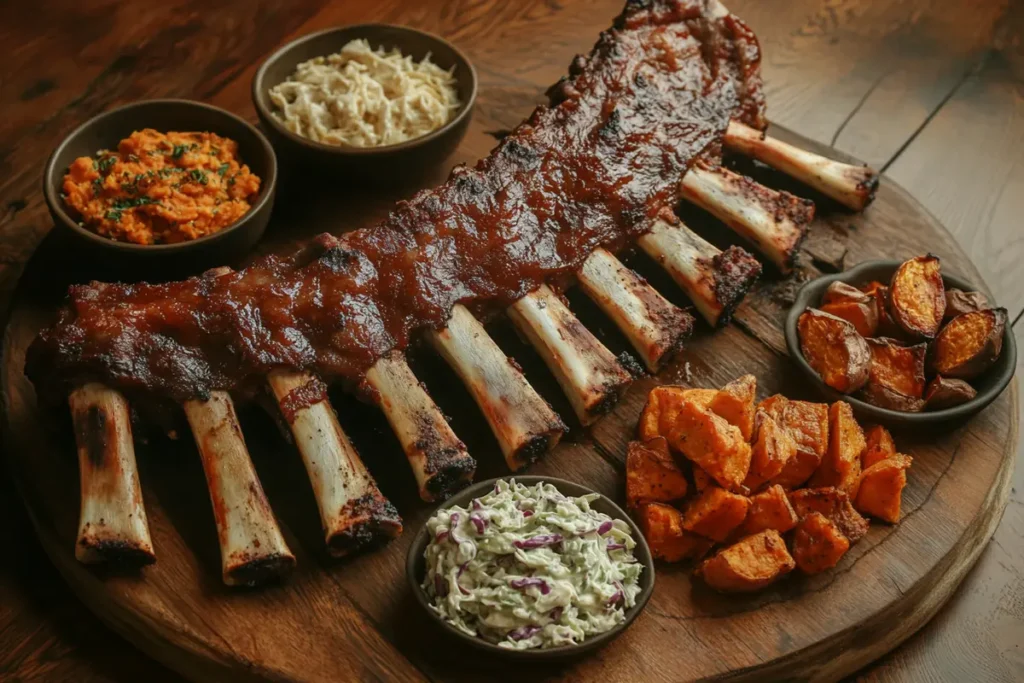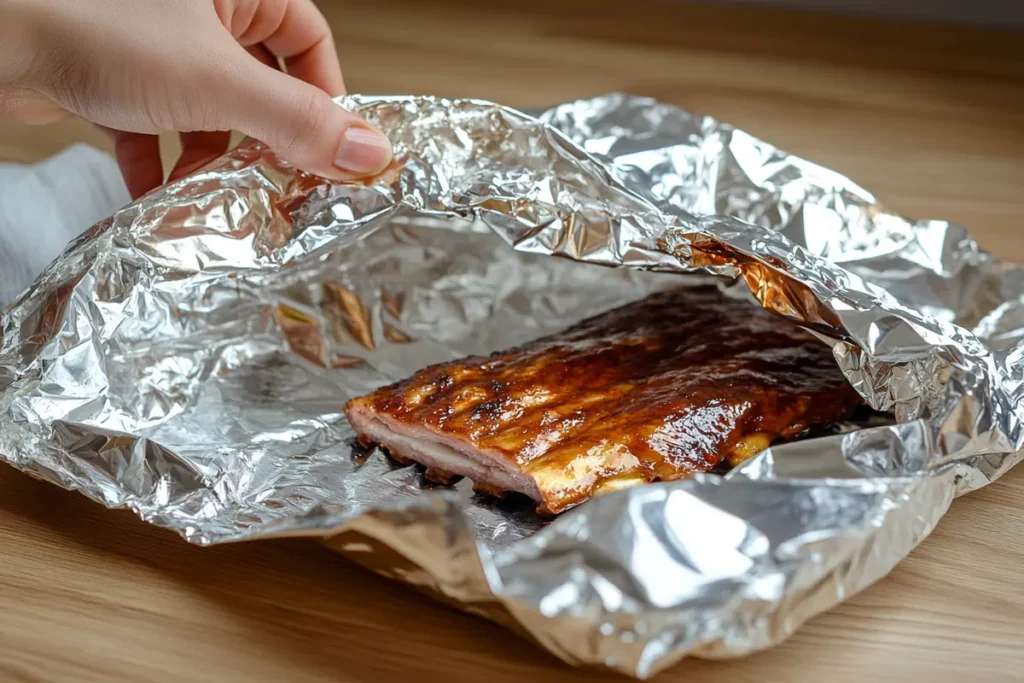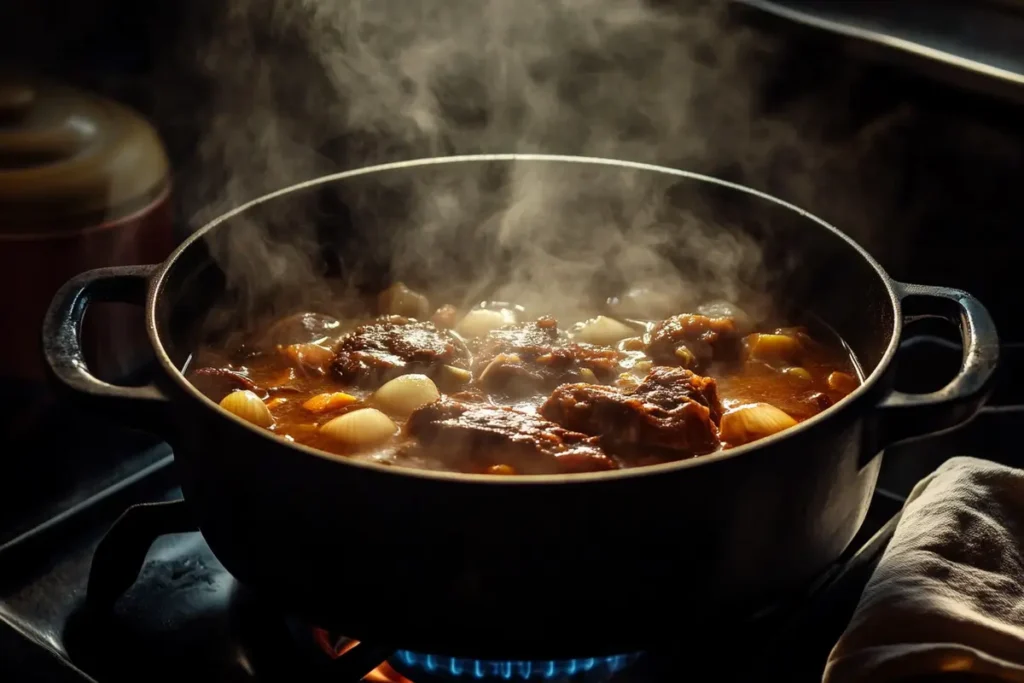Understanding Beef Back Ribs
Beef back ribs come from the same primal section as the ribeye steak, but don’t be fooled—they have a charm all their own. These ribs are the bones leftover once the ribeye roast is trimmed, meaning they boast the same depth of flavor associated with ribeye. If you’re wondering, what are beef back ribs good for, the answer lies in their incredible marbling and connective tissue. Although there’s not a ton of meat, these elements melt down beautifully when cooked right, creating a juicy bite that’s hard to forget.
Nutritional Profile of Beef Back Ribs
Nutritional Information of Beef Back Ribs (Per 100g)
| Nutrient | Amount (Per 100g) |
|---|---|
| Calories | 320 kcal |
| Protein | 22g |
| Total Fat | 26g |
| Saturated Fat | 11g |
| Cholesterol | 85mg |
| Sodium | 72mg |
| Iron | 2.6mg |
| Zinc | 5.2mg |
If you’re wondering about the health benefits, beef back ribs can fit into a balanced diet when prepared wisely. They’re high in protein—essential for muscle repair—and rich in vitamins like B12 and zinc, which support energy and immune function. However, they also contain a higher fat content, so moderation is key. Slow-cooking methods like braising help render the fat, making them both healthier and tastier.
Comparing Beef Back Ribs to Other Rib Cuts
When it comes to choosing between different rib cuts, it can feel like splitting hairs—but there are distinct differences! Beef back ribs come from the upper part of the rib cage, near the spine, and have less meat compared to short ribs. In contrast, short ribs are cut from the lower rib section and are loaded with meat. And what about pork ribs? They’re leaner and milder, which makes beef ribs stand out with their hearty, beefy flavor. If you’re craving something robust and smoky, beef back ribs are your go-to.
Selecting Quality Beef Back Ribs
Picking the right ribs at the butcher counter can make or break your dish. Here’s what to look for:
- Meat Coverage: Go for ribs with thick layers of meat between the bones—avoid racks where the bones (known as “shiners”) are overly exposed.
- Color and Fat: Fresh ribs should have a deep red color with creamy-white fat. Avoid dull, grayish meat.
- Marbling: A good balance of marbling ensures the ribs remain moist during cooking.
The next time you’re browsing for ribs, these tips will have you shopping like a pro!
Culinary Uses of Beef Back Ribs
Grilling Beef Back Ribs

Grilling is one of the most popular ways to prepare beef back ribs—and for good reason! The smoky char from the flames combined with the rich, beefy flavor creates an irresistible combination. However, because these ribs don’t have as much meat as other cuts, it’s crucial to cook them low and slow.
Steps for Perfectly Grilled Beef Back Ribs:
- Prepping the Ribs: Start by removing the membrane from the bone-side of the ribs—it can be tough and chewy if left intact.
- Seasoning: Rub the ribs generously with your favorite dry rub, ensuring that every inch is coated. A blend of smoked paprika, garlic powder, onion powder, and brown sugar works wonders!
- Indirect Heat: Preheat your grill to medium-low heat (around 250-275°F). Place the ribs bone-side down on the cooler side of the grill to prevent scorching.
- Cooking Time: Grill for 1.5 to 2 hours, checking every 30 minutes. Brush with a tangy barbecue sauce during the last 20 minutes for a caramelized finish.
The result? Tender ribs with a crispy bark that tastes just as good as it looks!
Smoking Beef Back Ribs
Smoking is an art, and beef back ribs shine in this slow, flavorful cooking method. If you’ve never smoked ribs before, don’t worry—it’s all about patience and the right wood chips.
Smoking Method:
- Wood Selection: Opt for woods like hickory or oak to complement the robust flavor of beef.
- Temperature Control: Set your smoker to a steady 225°F. Low heat ensures the ribs cook evenly without drying out.
- Timeframe: Smoke for around 4 to 6 hours, spritzing the ribs every hour with apple cider vinegar or broth to maintain moisture.
- Bonus Tip: Wrapping the ribs in foil after 3 hours (also known as the “Texas crutch”) locks in juices and speeds up the cooking process.
When you’re done, the ribs should have a deep mahogany color and a smoky aroma that’ll make your mouth water.
Braising Beef Back Ribs
If you’re a fan of melt-in-your-mouth textures, braising is your best bet. This method involves slow-cooking the ribs in liquid, making them fork-tender and flavorful.
How to Braise Beef Back Ribs:
- Searing: Start by searing the ribs in a hot skillet with a little oil to get a nice brown crust.
- Flavor Base: In the same pan, sauté onions, garlic, and a touch of tomato paste for a rich umami boost.
- Liquid: Add beef broth, a splash of Worcestershire sauce, and your favorite herbs. The liquid should come about halfway up the ribs.
- Slow Cook: Cover the pot and let it simmer gently for 2-3 hours, either on the stovetop or in the oven at 325°F.
The result? Fall-off-the-bone ribs in a rich, savory sauce perfect for spooning over mashed potatoes or rice.
Oven-Baking Beef Back Ribs

If you don’t have access to a grill or smoker, don’t worry—oven-baked beef back ribs can be just as delicious! The key is to create a “low and slow” environment inside your oven.
Steps for Oven-Baked Beef Back Ribs:
- Preheat the Oven: Set your oven to 275°F for slow cooking.
- Wrap for Tenderness: Place the seasoned ribs on a foil-lined baking sheet and wrap them tightly with foil to trap the steam.
- Bake Time: Bake for 2.5 to 3 hours until the ribs are tender.
- Finishing Touch: Unwrap, brush with barbecue sauce, and broil for 3-5 minutes until the sauce is bubbly and caramelized.
Oven-baked ribs offer the convenience of indoor cooking while still delivering bold flavors.
Incorporating Beef Back Ribs into Recipes
Who says you have to stick to plain ribs? These versatile cuts can be used in all sorts of creative ways.
Recipe Ideas for Beef Back Ribs:
- Beef Rib Tacos: Shred the meat and load up soft tortillas with guacamole, salsa, and pickled onions.
- Beef Rib Stew: Add chunks of beef back ribs to a slow-simmering stew with root vegetables for a hearty dish.
- Barbecue Beef Flatbread: Use rib meat as a topping for flatbread, paired with caramelized onions and a smoky barbecue drizzle.
These ideas are just the tip of the iceberg—you can get as creative as you want with these flavorful cuts by trying a beef back ribs recipe.
Grilling Beef Back Ribs
Grilling is one of the most popular ways to prepare beef back ribs—and for good reason! The smoky char from the flames combined with the rich, beefy flavor creates an irresistible combination. However, because these ribs don’t have as much meat as other cuts, it’s crucial to cook them low and slow.
Steps for Perfectly Grilled Beef Back Ribs:
- Prepping the Ribs: Start by removing the membrane from the bone-side of the ribs—it can be tough and chewy if left intact.
- Seasoning: Rub the ribs generously with your favorite dry rub, ensuring that every inch is coated. A blend of smoked paprika, garlic powder, onion powder, and brown sugar works wonders!
- Indirect Heat: Preheat your grill to medium-low heat (around 250-275°F). Place the ribs bone-side down on the cooler side of the grill to prevent scorching.
- Cooking Time: Grill for 1.5 to 2 hours, checking every 30 minutes. Brush with a tangy barbecue sauce during the last 20 minutes for a caramelized finish.
The result? Tender ribs with a crispy bark that tastes just as good as it looks!
Smoking Beef Back Ribs
Smoking is an art, and beef back ribs shine in this slow, flavorful cooking method. If you’ve never smoked ribs before, don’t worry—it’s all about patience and the right wood chips.
Smoking Method:
- Wood Selection: Opt for woods like hickory or oak to complement the robust flavor of beef.
- Temperature Control: Set your smoker to a steady 225°F. Low heat ensures the ribs cook evenly without drying out.
- Timeframe: Smoke for around 4 to 6 hours, spritzing the ribs every hour with apple cider vinegar or broth to maintain moisture.
- Bonus Tip: Wrapping the ribs in foil after 3 hours (also known as the “Texas crutch”) locks in juices and speeds up the cooking process.
When you’re done, the ribs should have a deep mahogany color and a smoky aroma that’ll make your mouth water.
Braising Beef Back Ribs

If you’re a fan of melt-in-your-mouth textures, braising is your best bet. This method involves slow-cooking the ribs in liquid, making them fork-tender and flavorful.
How to Braise Beef Back Ribs:
- Searing: Start by searing the ribs in a hot skillet with a little oil to get a nice brown crust.
- Flavor Base: In the same pan, sauté onions, garlic, and a touch of tomato paste for a rich umami boost.
- Liquid: Add beef broth, a splash of Worcestershire sauce, and your favorite herbs. The liquid should come about halfway up the ribs.
- Slow Cook: Cover the pot and let it simmer gently for 2-3 hours, either on the stovetop or in the oven at 325°F.
The result? Fall-off-the-bone ribs in a rich, savory sauce perfect for spooning over mashed potatoes or rice.
Oven-Baking Beef Back Ribs
If you don’t have access to a grill or smoker, don’t worry—oven-baked beef back ribs can be just as delicious! The key is to create a “low and slow” environment inside your oven.
Steps for Oven-Baked Beef Back Ribs:
- Preheat the Oven: Set your oven to 275°F for slow cooking.
- Wrap for Tenderness: Place the seasoned ribs on a foil-lined baking sheet and wrap them tightly with foil to trap the steam.
- Bake Time: Bake for 2.5 to 3 hours until the ribs are tender.
- Finishing Touch: Unwrap, brush with barbecue sauce, and broil for 3-5 minutes until the sauce is bubbly and caramelized.
Oven-baked ribs offer the convenience of indoor cooking while still delivering bold flavors.
Incorporating Beef Back Ribs into Recipes
Who says you have to stick to plain ribs? These versatile cuts can be used in all sorts of creative ways.
Recipe Ideas for Beef Back Ribs:
- Beef Rib Tacos: Shred the meat and load up soft tortillas with guacamole, salsa, and pickled onions.
- Beef Rib Stew: Add chunks of beef back ribs to a slow-simmering stew with root vegetables for a hearty dish.
- Barbecue Beef Flatbread: Use rib meat as a topping for flatbread, paired with caramelized onions and a smoky barbecue drizzle.
These ideas are just the tip of the iceberg—you can get as creative as you want with these flavorful cuts.
Flavor Pairings and Serving Suggestions
Ideal Marinades and Rubs for Beef Back Ribs
The right marinade or rub can take beef back ribs from good to unforgettable. Since these ribs have a bold, beefy flavor, they pair well with both savory and slightly sweet seasonings.
Popular Marinade Ideas:
- Garlic and Herb Marinade: A blend of olive oil, fresh rosemary, thyme, minced garlic, and lemon juice adds a bright, savory punch.
- Smoky Chipotle Marinade: Combine chipotle peppers in adobo, lime juice, honey, and cumin for a smoky, spicy kick.
- Asian-Inspired Marinade: A mixture of soy sauce, ginger, brown sugar, and sesame oil creates a sweet-savory glaze that’s hard to resist.
Go-To Dry Rubs:
- Classic Barbecue Rub: Smoked paprika, garlic powder, onion powder, black pepper, and brown sugar form the base for a traditional barbecue rub.
- Coffee and Cocoa Rub: A surprising blend of ground coffee, cocoa powder, salt, and cayenne creates a rich, earthy crust.
- Mustard Seed and Black Pepper Rub: Coarse-ground mustard seeds and cracked black pepper add a tangy, peppery bite.
Don’t be afraid to experiment—rubs and marinades let you customize your ribs to suit your mood and palate.
Side Dishes to Serve with Beef Back Ribs
No rib feast is complete without the perfect side dishes. The richness of beef back ribs pairs well with sides that balance their bold flavor.
Classic Rib Side Dishes:
- Coleslaw: A creamy or tangy slaw adds a refreshing crunch to balance the ribs’ richness.
- Cornbread: Slightly sweet and crumbly, cornbread is a perfect complement to smoky ribs.
- Baked Beans: Slow-cooked beans in a savory-sweet sauce enhance the barbecue vibe.
Lighter Alternatives:
- Grilled Vegetables: Charred bell peppers, onions, and zucchini provide a healthy, smoky side.
- Roasted Sweet Potatoes: Their natural sweetness pairs beautifully with the savory spices on the ribs.
- Fresh Green Salad: A salad with citrus vinaigrette can cut through the richness of the ribs and refresh your palate.
Mix and match sides to create a meal that’s as balanced as it is flavorful.
Beverage Pairings with Beef Back Ribs
While drinks can enhance a meal, you don’t need anything fancy. Instead of wine or alcohol, try refreshing non-alcoholic options that highlight the ribs’ flavors.
Delicious Non-Alcoholic Options:
- Iced Tea with Lemon: The subtle bitterness of black tea pairs well with smoky and savory ribs.
- Sparkling Water with Citrus: A bubbly drink with a splash of lime or orange helps cleanse your palate between bites.
- Homemade Lemonade: The sweet and tangy flavors provide a refreshing contrast to the richness of the ribs.
Sticking with simple, flavorful drinks ensures that the ribs remain the star of the show.
Presentation Tips for Beef Back Rib Dishes
The way you serve your beef back ribs can make them even more inviting. A little attention to detail goes a long way!
Serving Suggestions:
- Plating: Arrange the ribs in a fan-like shape on a large wooden board or platter for a rustic touch.
- Garnishes: Add a sprinkle of fresh parsley or chives for a pop of color and freshness.
- Sauce Presentation: Serve barbecue sauce or dipping sauces in small bowls on the side to let guests customize their bites.
A visually appealing presentation makes the meal feel special and elevates the dining experience.
Frequently Asked Questions about Beef Back Ribs
What are beef back ribs?
Beef back ribs are the long, curved bones left behind after the ribeye roast or rib steaks are removed from the primal rib section. They contain less meat than short ribs but are prized for their rich, beefy flavor. Most of the meat sits between the bones rather than on top, making them perfect for slow-cooked methods that render the connective tissue into tender, flavorful bites.
How do beef back ribs differ from short ribs?
Short ribs come from the lower rib section, near the belly, while beef back ribs come from the upper rib section closer to the spine. Short ribs are meatier and have more connective tissue, which makes them ideal for braising. In contrast, beef back ribs are lighter on meat but offer a stronger beef flavor, making them perfect for grilling, smoking, or baking.
How long should I cook beef back ribs?
Cooking times vary depending on the method:
Grilling: 1.5 to 2 hours at medium-low heat (250-275°F).
Smoking: 4 to 6 hours at 225°F.
Braising: 2 to 3 hours at 325°F.
Oven-Baking: 2.5 to 3 hours at 275°F.
The ribs are ready when the meat is tender and starts to pull away from the bones but doesn’t fall apart completely.
How should I store leftover beef back ribs?
If you have leftover ribs, store them in an airtight container in the refrigerator for up to 4 days. For longer storage, wrap them tightly in foil or plastic wrap, place them in a freezer-safe bag, and freeze for up to 3 months. When reheating, avoid the microwave as it can dry out the meat—opt for the oven instead to keep them moist and tender.
Conclusion of Beef Back Ribs
Beef back ribs may not be the meatiest cut, but they’re packed with bold, savory flavors that shine when cooked properly. Whether you prefer the smoky char of grilled ribs, the slow tenderness of braised ribs, or the convenience of oven-baked recipes, these versatile ribs can be transformed into unforgettable meals. Pair them with the right marinades, side dishes, and thoughtful presentation to elevate your dining experience.
By understanding what beef back ribs are good for, you can make the most of this underrated cut and impress friends and family at your next gathering. So the next time you’re craving ribs, don’t overlook beef back ribs—they’re a delicious option that deserves to be in the spotlight!

